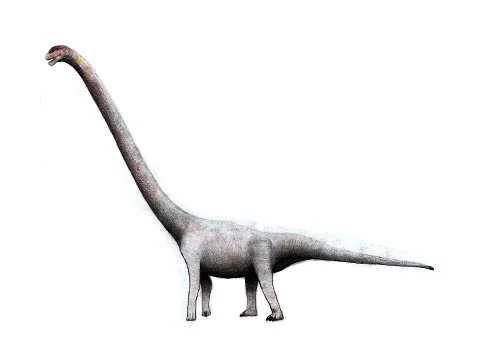Omeisaurus (Omei lizard - after Omeishan Mountain)

O-may-sore-us
C. C. Young - 1939
Herbivore
Estimated up to 20 meters long
Sauropod
O. junghsiensis (type), O. changshouensis, O. fuxiensis, O. jiaoi, O. luoquanensis, O. maoianus, O. puxiani, O. tianfuensis
China - Sichuan Province - Dashanpu/Lower Shaximiao Formation. Possibly also the Upper Shaximiao though these remains are widely regarded as being indeterminate
Late Jurassic, 165-155 million years ago
Omeisaurus Facts
Omeisaurus was a sauropod dinosaur that lived during the Late Jurassic period, approximately 165-155 million years ago. It was a large herbivorous dinosaur that had a long neck and tail, and walked on four legs. Its fossils have been found in China, and it is one of the most well-known and well-studied dinosaurs from that country.
Omeisaurus was a massive dinosaur, with some species reaching lengths of up to 20 meters (66 feet) and weighing up to 20 tons. Its long neck was made up of up to 19 cervical vertebrae, and it is estimated to have been able to reach heights of up to 9 meters (30 feet) to feed on the leaves of tall trees. Omeisaurus had a relatively small head with peg-like teeth that it likely used to strip leaves off of branches.
The fossils of Omeisaurus have provided valuable information about the anatomy and behavior of sauropod dinosaurs. In addition to its long neck and tail, Omeisaurus had a wide, barrel-shaped body and a strong, column-like set of legs that were capable of supporting its massive weight. Its teeth and jaw structure suggest that it was a selective browser, and likely fed on high-quality vegetation to sustain its large body size.
The discovery of Omeisaurus and other sauropod dinosaurs has been important in understanding the evolution of dinosaurs and the ecosystems in which they lived. Sauropods were some of the largest land animals to ever exist, and their massive size likely played an important role in shaping the environments in which they lived.
In conclusion, Omeisaurus was a massive herbivorous dinosaur that lived during the Late Jurassic period in what is now China. Its long neck, wide body, and massive size are characteristic of the sauropod dinosaurs, a group of animals that were some of the largest to ever exist. The study of dinosaurs like Omeisaurus helps us to better understand the diversity of life that existed on Earth millions of years ago, and the important role that paleontology plays in uncovering and understanding this history.



